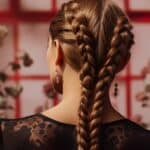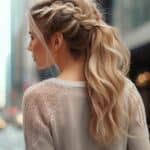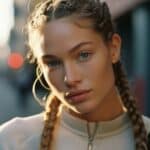Weaving braids hairstyles have been popular among individuals for centuries, bringing a unique blend of artistry and practicality to hair care. These intricate styles incorporate hair extensions, or weaves, into natural hair to enhance length and volume and create stunning braided patterns. With various weaving techniques, one can experiment with different looks to suit various occasions and personal preferences.
The history and evolution of weaving braids hairstyles trace its roots back to different cultures and eras, continuing to evolve to suit modern trends. From traditional African styles to contemporary, chic designs, weaving braids has grown to adapt to various hair types and individual tastes. The versatility of weave braid hairstyles means a style perfect for everyone, whether it’s an elegant half-up ponytail or a trendy two-braid hairstyle.
Understanding the fundamentals and proper care techniques is crucial to successfully achieving and maintaining weave braid hairstyles. This article will explore the numerous popular weaving braid hairstyles and provide a step-by-step guide to their creation and helpful tips for maintaining these unique looks. Moreover, the article will touch upon the advantages and disadvantages of weaving braids and guide you in choosing the perfect braided hairstyle for your face shape.
Key Takeaways
- Weaving braids hairstyles offer a blend of artistry and practicality, utilizing hair extensions to create intricate designs.
- With a rich history and cultural significance, weaving braids have evolved into various modern styles suitable for different hair types and preferences.
- Properly understanding fundamentals, creation techniques, and hair care is crucial for maintaining and enjoying the beauty of weave braid hairstyles.

History and Evolution of Weaving Braids Hairstyles
Braids have a long and fascinating history, dating back thousands of years in various cultures across the globe. Braiding techniques and styles have evolved, reflecting shifts in fashion trends and social changes. Throughout history, braids served as a practical means of managing hair and a means of social connection, with elders often teaching younger generations how to create intricate and beautiful hairstyles.
In the context of protective styles, braids are known for preserving hair health by minimizing the stress placed on hair strands. This hairstyle has been particularly significant for people of color, as it is deeply intertwined with the resilience and psychological trauma experienced through colonization and trans-Atlantic slavery.
One example of the diversity and evolution of braid styles can be observed in the dreadlocks style, which is commonly associated with 20th-century Jamaican and Rastafarian culture. However, this hairstyle’s origins extend far beyond this period and culture, as described in Dr. Bert Ashe’s book, Twisted: My Dreadlock Chronicles. Dreadlocks have been worn for centuries by various cultural groups and represent just one of many manifestations of the braided hairstyle.
The modern era has witnessed an expansion of braiding techniques and innovations, with countless new styles emerging to reflect shifting cultural and aesthetic preferences. Some examples of these contemporary styles include box braids, cornrows, and crochet braids, each offering unique variations that cater to individual tastes and needs.
The history and evolution of weaving braids and hairstyles highlight the creativity and ingenuity of human expression. As braids continue to evolve, they remain a culturally significant and practical way to protect and showcase the beauty of natural hair.
Fundamentals of Weaving Braids Hairstyles
Types of Braids
Several types of braids can be incorporated into different hairstyles for various occasions and preferences. These braided hairstyles are popular for those looking to protect their natural hair while pursuing a stylish and unique look. Some popular braid styles include:
- Cornrow ponytail: A neatly braided hairstyle where the hair is braided close to the scalp in straight rows, ending in a ponytail.
- Stitch braids: A modern twist on the traditional cornrow hairstyle characterized by visible grid-like parts.
- French braids: A classic braiding style where hair is divided into three sections and continuously braided, gradually incorporating more hair into the braid while moving downwards.
- Dutch braids: A reverse version of the French braid, in which the strands of hair are crossed beneath one another rather than over, resulting in a more raised and textured braid appearance.
- Feed-in braids: Similar to cornrows but with smaller strands of hair extensions gradually added as the natural hair is braided. This style helps alleviate tension on the scalp and create a more seamless appearance.
Types of Weaves
Weaves are a popular method of adding extensions to natural hair to create longer, fuller, or different-textured hairstyles. The following are some common types of weaves used in braided hairstyles:
- Lace front weave: A type of hair weave with a pre-made lace netting base, which can be customized to fit the shape of the wearer’s hairline. The lace front offers a natural-looking hairline and can be added to braided hairstyles for added length or volume.
- Sew-in weave: A method where additional hair is secured into natural hair through a series of braided foundation hair rows and needle-thread stitching. This type of weave can create the desired braided hairstyle by adding straight, wavy, or curly hair extensions of various lengths and colors.
Incorporating weaves into braided hairstyles can provide a versatile and protective style for those with natural hair. With various braid styles available, combined with different hair weaves, numerous unique and attractive hairstyles can be achieved while maintaining the natural hair’s health and integrity.
Step-by-Step Guide to Weaving Braids Hairstyles
Weaving braids hairstyles have gained popularity due to their versatility and protective nature in hair styling. Incorporating hair extensions, weaves, and different types of braids, such as box braids, tribal braids, and more, can create a unique look that stands out. This guide will walk you through creating several weaving braid hairstyles straightforwardly and clearly.
Braid Hairstyles with Weaves
To create a braid hairstyle with a weave, first, you need to prepare the hair by washing and conditioning it. Make sure the hair is completely dry before proceeding. Then, the hair can be sectioned off and divided into smaller portions, depending on your desired braid size. Utilize hair extensions to add length and volume to the braids. Some popular braid styles achieved with weaves include goddess, box, and tribal braids.
Individual Braids
Individual braids are a versatile and unique style that can be created with or without weave additions. Start by sectioning your hair into smaller parts, typically rectangular or square. You can add hair extensions to each section, using your natural hair as the anchor. Braid each section using the three-strand braiding technique, ensuring the weave is blended well with your natural hair. To create a more intricate look, goddess braids can also be done as individual braids.
Cornrow Ponytail
A cornrow ponytail combines the classic style of cornrows and the functionality of a ponytail. Begin by parting your hair into small sections parallel to your forehead. Create cornrows by braiding your hair close to the scalp until you reach the point where you want the ponytail to start. Once all sections are braided into cornrows, gather them together and secure them with a hairband to create a ponytail. Use hair extensions or weave pieces in your cornrows for added length and volume.
Stitch Braids
Stitch braids are a variation of cornrows, utilizing a specific parting technique to create a neat, organized look. Start by parting the hair in your desired pattern, often using straight lines or boxed sections. Braid each section close to the scalp, ensuring the parts remain visible between the braids. Weaves can be added as desired to create fuller and longer braids. This technique can also be adapted for French braids, creating a more dimensional look.
Whether you incorporate weaves or hair extensions into your braids or opt for natural hair, these weaving braid hairstyles provide a wide range of options to suit any preference. From individual braids and goddess braids to cornrow ponytails and stitch braids, the possibilities are endless to create unique and stunning looks.
Popular Weaving Braid Hairstyles
Box Braids with Weave
Box braids are popular for those looking to add length and thickness to their natural hair. They are a protective style that helps minimize damage and promote hair growth. With the addition of hair extensions, box braids with weave offer versatility and a wide range of styling options.
High Ponytail Braid
A high ponytail braid is a stylish and sophisticated option for elevating their everyday hairstyle. This look is achieved by gathering all the hair into a high ponytail and then braiding it down to the ends. The result is a chic and elegant style that can be dressed up or down for any occasion.
Butterfly Braid
The butterfly braid is a unique and eye-catching style that features a large, voluminous braid woven down the center of the head. This intricate hairstyle is created by weaving sections of hair onto the central braid, creating a floating, butterfly-wing effect. Ideal for special events and occasions, the butterfly braid is a stunning choice for those seeking a statement hairdo.
Braided Bun
The braided bun is a versatile and classic look that works equally well for casual days or formal events. To create this style, the hair is braided and then wrapped into a bun at the back of the head. This elegant updo is functional and fashionable, making it a popular choice for various settings.
Braided Ponytail
Braided ponytails combine a ponytail’s simplicity with a braid’s added flair. The hair is gathered into a ponytail and then braided to the ends to create this look. This style can be personalized by experimenting with different braiding techniques, such as fishtail, French, or Dutch braids.
Half Up Ponytail
A half-up ponytail offers a versatile and fashionable option for those seeking a relaxed and refined hairstyle. This style is achieved by gathering the top section of the hair into a ponytail while leaving the bottom half loose and flowing.
Cornrow Ponytail
The cornrow ponytail is an elegant and intricate style that combines the sleekness of cornrows with the sophistication of a gathered ponytail. In this hairstyle, multiple rows of tight cornrows are braided along the scalp, reaching towards the back of the head, where they are then gathered into a single ponytail.
Fishtail Braids
Fishtail braids are a stylish and intricate variation of traditional braiding techniques. To create this look, the hair is divided into two sections and woven together by repeatedly pulling small strands from the outer edges towards the center. The fishtail braid offers a unique and intricate appearance, making it a popular choice for those seeking a fashionable twist on classic braids.
French Braids
French braids are a classic and elegant option that involves weaving strands of hair together, gradually incorporating additional sections as the braid moves down the head. This timeless style is versatile, works well for casual and formal occasions, and can easily adapt to various hair lengths and textures.
Dutch Braids
Dutch braids are similar to French braids but are created by weaving the hair strands under, rather than over, each section. This difference in technique results in a raised, three-dimensional braid that adds texture and depth to the overall hairstyle. Dutch braids are a fashionable and unique option for those experimenting with various braiding styles.
Feed-In Braids
Feed-in braids are popular for individuals with short or fine hair who wish to add length and thickness to their hairstyle. This technique involves gradually incorporating hair extensions into the natural hair as it is braided. Feed-in braids can create various styles, from simple braided ponytails to more elaborate updos.
Tips for Maintaining Braided Hairstyles
Braided hairstyles are popular and versatile for any hair type or texture. They are an excellent protective style, allowing natural hair to rest and grow while preventing potential damage from styling tools. Here are a few tips for maintaining braided hairstyles, such as weaves and hair extensions.
First and foremost, keeping your scalp and braids clean is essential. Contrary to popular myth, washing your hair when you have braids does not ruin the style. Cleansing is crucial for preventing product buildup, dryness, and irritation. Opt for gentle pre-shampoo treatments or clarifying shampoos designed to clean without pulling or loosening the braids.
In addition to focusing on scalp hygiene, moisturizing your natural hair and hair extensions is essential in maintaining braided styles. Use a light oil spray or a leave-in conditioner to keep the braids and your hair healthy and hydrated. This routine should be followed with a weekly spritz of dry shampoo to preserve the style, prevent frizz, and keep your hair smelling fresh.
Moreover, dealing with braided hairstyles’ potential itchiness and discomfort is equally essential. Choose a high-quality braid spray to relieve an itchy scalp, and avoid using heavy oils and greasy products, as they can irritate. Instead, opt for lightweight or water-based products for soothing and moisturizing the scalp.
Lastly, proper nighttime care is crucial for maintaining the appearance and longevity of braided hairstyles. Protect your hair by covering it with a satin or silk scarf or sleeping on a satin or silk pillowcase. This extra protection helps reduce frizz and prevents breakage, ensuring your natural hair and extensions stay in top condition.
Incorporating these tips into your hair care routine will help you maintain and enjoy your braided hairstyles, keeping them looking great while preserving the health of your natural hair.
Advantages and Disadvantages of Weaving Braids Hairstyles
Weaving braids hairstyles have become increasingly popular as a protective style for natural hair. They can provide several benefits but also come with some drawbacks. This section will outline the advantages and disadvantages of weaving braids hairstyles, using a confident, knowledgeable, neutral, and clear tone in the third person.
One of the main advantages of weaving braids hairstyles is its ability to serve as a protective style for natural hair. Covering the natural hair with braids, it shields the hair from potential damage caused by harsh weather conditions, styling tools, or chemical processes. This can help maintain healthy hair and prevent breakage.
Another advantage to weaving braids is their versatility. Numerous braiding styles include crown braids, French braids, and twists. This allows for a wide range of creative and unique looks tailored to an individual’s style.
However, weaving braids and hairstyles also come with some disadvantages. The first of these is the cost. Braids can be expensive depending on the desired style’s length, size, and intricacy. The price of the braid installation is also affected by the salon or hairstylist chosen.
Next, the time-consuming nature of the installation should be considered. The process of weaving braids can take 6-8 hours or more, depending on the braids’ chosen style, length, and size. This long duration may not be convenient for those with busy schedules.
Additionally, improper installation or maintenance of braids can potentially cause hair damage. Instances of Central Centrifugal Cicatricial Alopecia (CCCA) and Traction Alopecia have been linked to wearing braids and weaves. These conditions are caused by chronic pulling on the hair follicle and can lead to irreversible baldness.
In terms of weaves, they are typically attached to braided hair using sewn-down cornrows as the foundation. While this offers an additional protective layer, ensuring the cornrows are not too tight is essential, as it can cause discomfort and strain the hair follicles.
In conclusion, weaving braids and hairstyles offer a stylish and protective option for natural hair. However, weighing the advantages and disadvantages before committing to this investment of time and money is crucial. Proper installation and maintenance are vital to ensuring your hair remains healthy while wearing braids.
Choosing the Right Braided Hairstyle for Your Face Shape
When selecting a braided hairstyle, it’s crucial to consider the shape of your face to achieve a balanced and flattering look. By aiming for an oval shape, the most universally pleasing facial shape, you can enhance your features and create harmony.
A fishtail top knot can be an excellent choice for those with a round face. This braided hairstyle elongates the face by drawing the eye upwards, which creates the illusion of a longer, slimmer face. To achieve this look, tie your hair into a high pony, separate it into two even sections, and then weave a small piece from the left side under the right, and vice versa.
Incorporating braids with a weave can also result in flattering styles for various face shapes. A popular choice is the halo braid hairstyle with a weave, also known as the crown braid. This hairstyle is suitable for most face shapes, as it frames the face with a beautiful braided circle. It’s a quick and low-effort option that only requires you to set and pin up the braid properly.
Another versatile braided hairstyle is the two-styled braid, a unique combination of a Dutch braid and a fishtail braid. It starts with a deep side part and a Dutch braid extending just below the ear, finishing with a half-inch strand of your hair wrapped around the base. This hairstyle can add dimension to any face shape, especially with face-framing layers.
For those with long faces, a high ponytail with braids can be flattering, drawing the eye upwards and making the face appear longer. This versatile style works well for various occasions, from the office to a night out.
Remember, when choosing a braided hairstyle, the goal is to create a balanced look that complements your facial features. By considering your face shape and selecting a suitable braided style, you can achieve a stunning and flattering hairstyle that enhances your natural beauty.
Conclusion
Weave and braid hairstyles offer a variety of benefits and can be a fashionable choice for those looking to protect their natural hair. These hairstyles can be customized to fit individual preferences and offer a versatile, low-maintenance option that promotes healthy hair growth.
Individual braids, such as box braids, are an excellent option for those who enjoy swimming, as they keep the hair from getting tangled and out of the face. These braids also provide the opportunity to experiment with different updo styles, braid-on-braid looks, and accessories.
In contrast, weaves can provide a more seamless integration with your natural hair, allowing for a broader range of styles without excessive hair manipulation. Weaves are often considered a more temporary solution than braids, making them an excellent choice for frequently changing hairstyles.
Protective styles, such as braids and weaves, are essential for maintaining the health and well-being of natural hair. They reduce breakage, promote growth, and allow the hair to retain moisture. However, it is important to note that improper application or wearing these styles too tightly can lead to hair loss, such as Central Centrifugal Cicatricial Alopecia (CCCA) or Traction Alopecia.
In summary, weave and braid hairstyles provide unique advantages regarding versatility, natural hair protection, and style options. Choosing between the two ultimately depends on personal preference and the specific hair needs of the individual. Careful consideration should be taken when selecting a stylist to ensure these protective styles are executed correctly, minimizing the risk of hair damage or loss.
Frequently Asked Questions
What are the top protective styles that incorporate braids and weave?
Several protective styles combine braids and weaves, offering both style and protection for natural hair. Some top protective styles include sew-in weaves with cornrows, box braids with extensions, and crochet braids. These hairstyles keep the natural hair braided and covered, reducing the risk of damage from heat and tension.
Which braided weave extensions are popular in 2023?
In 2023, popular braided weave extensions include knotless box braids, passion twists, goddess braids, and faux locs. These styles provide a trendy and versatile look while offering the benefits of a protective style for natural hair.
How do box braids with weave differ from other styles?
Box braids with weaves differ from other styles because they section the hair into squares or “boxes” before braiding. This technique creates a uniform and organized appearance and can be easily customized by adjusting the size and length of the braids. Additionally, box braids typically use synthetic or human hair extensions interwoven with natural hair, resulting in a fuller and more voluminous look.
What are some simple weaving hairstyles with attachment for adults?
Some simple weaving hairstyles with attachments suitable for adults include the half-up, half-down style, the side-swept braid, ponytail braids, and crown braids. These styles are easy to create and maintain, making them an ideal option for busy adults seeking a stylish yet low-maintenance look.
How to achieve a braided hairstyle with weaves and beads?
To achieve a braided hairstyle with weave and beads, follow these steps:
- Choose the desired braid style, such as cornrows, box braids, or twists.
- Section the hair accordingly and integrate the weave extensions.
- Braid the hair, ensuring the weave is securely attached to the natural hair.
- Once the braids are complete, add beads to the ends or along the braids using a beading tool or threading method. Secure the beads in place.
- Ensure the braids and beads are evenly distributed and neatly arranged for a polished look.
What are some trendy two-braid hairstyles using weave?
Some trendy two-braid hairstyles using weave include the double Dutch braids, two large cornrows, and double fishtail braids. These styles can be easily achieved with the help of extensions and provide a contemporary and eye-catching look that can be worn for various occasions.





